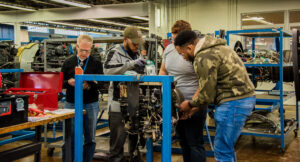As Aviation Recovers, Demand for Technicians Soars
Post-COVID comeback, retirements spur growth in essential maintenance jobs trained by schools like Pittsburgh Institute of Aeronautics
By Stephanie Hacke
Published July 12, 2021
Read Time: 3 mins
As the aviation industry emerges from the devastating effects of COVID-19, the demand for aviation technicians is once again on the rise.
“We’re beginning to feel that passion again,” said Karin McKenna, communications manager at the Pittsburgh Institute of Aeronautics [PIA]. “It’s starting to feel a little more like it did before COVID. Prior to COVID, our students were seeing all of those opportunities.”
In its most recent pilot and technician outlook report, issued in 2020, Boeing estimated that 739,000 new technicians would be needed worldwide during the next 20 years, much of it due to the large number of recent and upcoming retirements in the field.
That includes 192,000 new technicians needed in North America, assuming that air traffic will recover to 2019 levels within the next few years, according to the report.
While PIA experienced steady enrollment during the pandemic, it shifted its focus to sectors of the aviation industry that were less impacted—like cargo—for employment opportunities for its students, McKenna said.
“They are essential workers who are keeping flights running, whether it’s cargo, medical transportation, commercial flights,” she said. “They’ve really helped keep the world going and the world connected.”
Now companies are beginning to ramp up their recruitment and address the technician shortage, she added.
From nose to tail
Safety is the primary focus of maintenance technicians, who ensure everything from the lights on the wing to the engine are working properly before an aircraft leaves the ground.
The Pittsburgh Institute of Aeronautics was founded in 1929 and operates its main campus out of Allegheny County Airport in West Mifflin, Pa., just outside of Downtown Pittsburgh. Students spend 21 months getting their associate’s degree in aviation maintenance technology or aviation electronics technology.
In the maintenance program, as long as they pass all of their tests, students receive their airframe and powerplant technician certification shortly after graduation.
“The students are learning to work on all aspects of an aircraft, from nose to tail,” McKenna said. “It’s a very hands-on program.”

As of July 2021, PIA has over 500 students enrolled at its locations, including its main campus at AGC. (Photo by Beth Hollerich)
Students come from all walks of life, from straight out of high school to someone looking for a new career path. The one thing they all have in common is a love and passion for aviation, McKenna said.
Graduates have a wide array of options, from working in line maintenance on a commercial aircraft to working for a manufacturer to help build an aircraft.
As of this month, PIA had 509 students enrolled in its programs between the main campus and branch campuses in Youngstown, Ohio; Hagerstown, Maryland; and Myrtle Beach, South Carolina, officials said.
The demand
Even before the pandemic, aviation maintenance technicians were much in demand. Airframe and powerplant [A&P] certifications issued in 2019-20 rose by 10 percent over the previous year to 7,363, according to the Aviation Technician Education Council’s latest Pipeline Report.
Certifications dropped by 10 percent in the last academic year, likely due to COVID impacts, according to Crystal Maguire, executive director. The 2020-21 Pipeline Report has not yet been finalized.
Enrollments at A&P schools also dropped by 2 percent last year nationwide, following a record increase of 13 percent in enrollments in 2019.
Retirements in the field still outweigh the growth.
“Right before COVID we knew we needed to increase our annual output of new mechanics by 37 percent to meet 20-year demand,” Maguire said.
“If the long-term demand isn’t impacted by COVID, as suggested by last year’s Boeing outlook, we will need to increase our output while also making up for the 2020 ‘supply’ impacts,” she said, noting that she has yet to run the numbers for needed output this year.
For students at PIA, all of this means more opportunity.
“The students, I believe in the next several years, will really reap the benefits of those available positions,” McKenna said.
Leaders at PIA are working hard to get more students in the seats of technician schools, McKenna said.
“We have a number of students who, prior to graduation, have several job offers that they’re able to consider,” McKenna said. “They’re able to consider things like company benefits and location and what they really want to see happen with their career, instead of just taking the first job that comes along to them because that might be all that they get.”
Watch
This Next
Read
This Next





